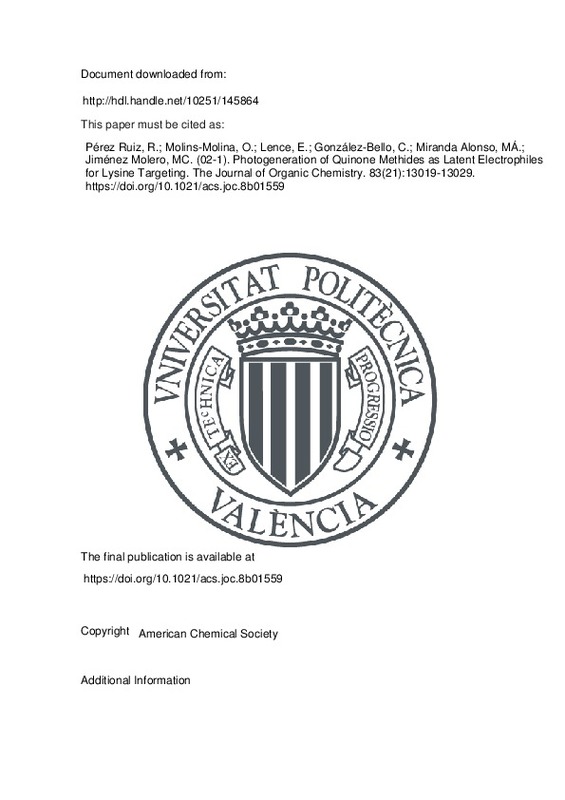JavaScript is disabled for your browser. Some features of this site may not work without it.
Buscar en RiuNet
Listar
Mi cuenta
Estadísticas
Ayuda RiuNet
Admin. UPV
Photogeneration of Quinone Methides as Latent Electrophiles for Lysine Targeting
Mostrar el registro sencillo del ítem
Ficheros en el ítem
| dc.contributor.author | Pérez Ruiz, Raul
|
es_ES |
| dc.contributor.author | Molins-Molina, Oscar
|
es_ES |
| dc.contributor.author | Lence, Emilio
|
es_ES |
| dc.contributor.author | González-Bello, Concepción
|
es_ES |
| dc.contributor.author | Miranda Alonso, Miguel Ángel
|
es_ES |
| dc.contributor.author | Jiménez Molero, María Consuelo
|
es_ES |
| dc.date.accessioned | 2020-06-10T03:32:21Z | |
| dc.date.available | 2020-06-10T03:32:21Z | |
| dc.date.issued | 2018-11-02 | es_ES |
| dc.identifier.issn | 0022-3263 | es_ES |
| dc.identifier.uri | http://hdl.handle.net/10251/145864 | |
| dc.description.abstract | [EN] Latent electrophiles are nowadays very attractive chemical entities for drug discovery, as they are unreactive unless activated upon binding with the specific target. In this work, the utility of 4-trifluoromethyl phenols as precursors of latent electrophiles, quinone methides (QM), for lysine-targeting is demonstrated. These Michael acceptors were photogenerated for specific covalent modification of lysine residues using human serum albumin (HSA) as a model target. The reactive QM-type intermediates I or II, generated upon irradiation of 4-trifluoromethyl-1-naphthol (1)@HSA or 4-(4-trifluorometylphenyl)phenol (2)@HSA complexes, exhibited chemoselective reactivity toward lysine residues leading to amide adducts, which was confirmed by proteomic analysis. For ligand 1, the covalent modification of residues Lys106 and Lys414 (located in subdomains IA and IIIA, respectively) was observed, whereas for ligand 2, the modification of Lys195 (in subdomain IIA) took place. Docking and molecular dynamics simulation studies provided an insight into the molecular basis of the selectivity of 1 and 2 for these HSA subdomains and the covalent modification mechanism. These studies open the opportunity of performing protein silencing by generating reactive ligands under very mild conditions (irradiation) for specific covalent modification of hidden lysine residues. | es_ES |
| dc.description.sponsorship | Financial support from the Spanish Ministry of Economy and Competiveness [CTQ2016-78875-P, SAF2016-75638-R and BES-2014-069404 (predoctoral fellowship to O.M.-M.)], the Generalitat Valenciana (PROMETEO/2017/075), the Community of Madrid (2016-T1/AMB-1275), the Xunta de Galicia (Centro Singular de Investigacion de Galicia accreditation 2016-2019, ED431G/09 and postdoctoral fellowship to E.L.), and the European Union (European Regional Development Fund, ERDF) is gratefully acknowledged. The proteomic analysis was performed in the proteomics facility of SCSIE University of Valencia that belongs to ProteoRed PRB2-ISCIII and is supported by grant PT13/0001, of the PE I+D+i 2013-2016, funded by ISCIII and FEDER. We are grateful to the Centro de Supercomputacion de Galicia (CESGA) for use of the Finis Terrae computer. | es_ES |
| dc.language | Inglés | es_ES |
| dc.publisher | American Chemical Society | es_ES |
| dc.relation.ispartof | The Journal of Organic Chemistry | es_ES |
| dc.rights | Reserva de todos los derechos | es_ES |
| dc.subject | Quinone methide | es_ES |
| dc.subject | Photochemistry | es_ES |
| dc.subject | Lysine targeting | es_ES |
| dc.subject.classification | QUIMICA ORGANICA | es_ES |
| dc.title | Photogeneration of Quinone Methides as Latent Electrophiles for Lysine Targeting | es_ES |
| dc.type | Artículo | es_ES |
| dc.identifier.doi | 10.1021/acs.joc.8b01559 | es_ES |
| dc.relation.projectID | info:eu-repo/grantAgreement/MINECO//CTQ2016-78875-P/ES/CONTROL SUPRAMOLECULAR DE LA FOTORREACTIVIDAD EN MEDIOS MICROHETEROGENOS BASADOS EN AMINOACIDOS: GELES MOLECULARES Y PROTEINAS TRANSPORTADORAS COMO NANORREACTORES./ | es_ES |
| dc.relation.projectID | info:eu-repo/grantAgreement/MINECO//SAF2016-75638-R/ES/DESARROLLO DE NUEVOS FARMACOS PARA EL TRATAMIENTO DE LAS INFECCIONES BACTERIANAS MULTIRESISTENTES: APROXIMACIONES QUE INCIDEN SOBRE VIABILIDAD, RESISTENCIA Y VIRULENCIA/ | es_ES |
| dc.relation.projectID | info:eu-repo/grantAgreement/Xunta de Galicia//ED431G%2F09/ | es_ES |
| dc.relation.projectID | info:eu-repo/grantAgreement/UV//PT13%2F0001/ | es_ES |
| dc.relation.projectID | info:eu-repo/grantAgreement/ISCIII//PT13%2F0001/ | es_ES |
| dc.relation.projectID | info:eu-repo/grantAgreement/MINECO//PT13%2F0001/ | es_ES |
| dc.relation.projectID | info:eu-repo/grantAgreement/MINECO//CTQ2013-47872-C2-1-P/ES/METABOLITOS FOTOACTIVOS/ | es_ES |
| dc.relation.projectID | info:eu-repo/grantAgreement/MINECO//BES-2014-069404/ES/BES-2014-069404/ | es_ES |
| dc.relation.projectID | info:eu-repo/grantAgreement/GVA//PROMETEO%2F2017%2F075/ES/Reacciones fotoquímicas de biomoléculas/ | es_ES |
| dc.rights.accessRights | Abierto | es_ES |
| dc.contributor.affiliation | Universitat Politècnica de València. Departamento de Química - Departament de Química | es_ES |
| dc.description.bibliographicCitation | Pérez Ruiz, R.; Molins-Molina, O.; Lence, E.; González-Bello, C.; Miranda Alonso, MÁ.; Jiménez Molero, MC. (2018). Photogeneration of Quinone Methides as Latent Electrophiles for Lysine Targeting. The Journal of Organic Chemistry. 83(21):13019-13029. https://doi.org/10.1021/acs.joc.8b01559 | es_ES |
| dc.description.accrualMethod | S | es_ES |
| dc.relation.publisherversion | https://doi.org/10.1021/acs.joc.8b01559 | es_ES |
| dc.description.upvformatpinicio | 13019 | es_ES |
| dc.description.upvformatpfin | 13029 | es_ES |
| dc.type.version | info:eu-repo/semantics/publishedVersion | es_ES |
| dc.description.volume | 83 | es_ES |
| dc.description.issue | 21 | es_ES |
| dc.identifier.pmid | 30274513 | es_ES |
| dc.relation.pasarela | S\372717 | es_ES |
| dc.contributor.funder | Xunta de Galicia | es_ES |
| dc.contributor.funder | Generalitat Valenciana | es_ES |
| dc.contributor.funder | Universitat de València | es_ES |
| dc.contributor.funder | Instituto de Salud Carlos III | es_ES |
| dc.contributor.funder | European Regional Development Fund | es_ES |
| dc.contributor.funder | Ministerio de Economía y Competitividad | es_ES |







![[Cerrado]](/themes/UPV/images/candado.png)

